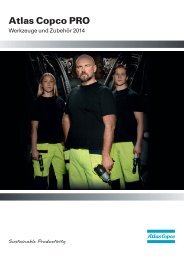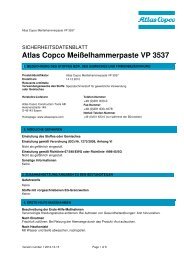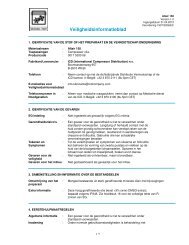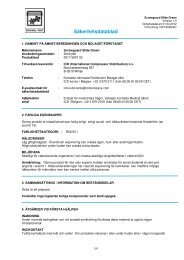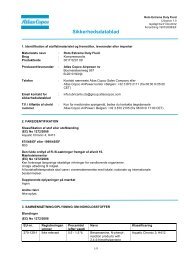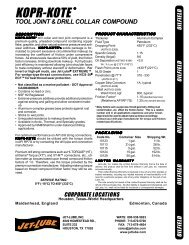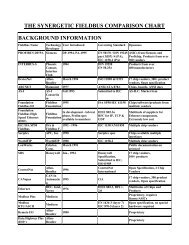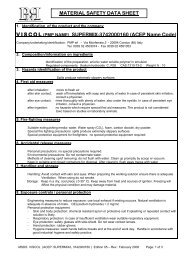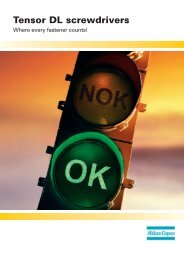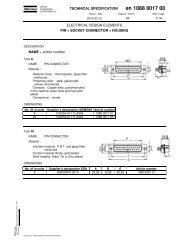PAROIL 5W40 - Atlas Copco
PAROIL 5W40 - Atlas Copco
PAROIL 5W40 - Atlas Copco
You also want an ePaper? Increase the reach of your titles
YUMPU automatically turns print PDFs into web optimized ePapers that Google loves.
<strong>PAROIL</strong> <strong>5W40</strong><br />
Safety Data Sheet<br />
<strong>PAROIL</strong> <strong>5W40</strong><br />
1. PRODUCT AND COMPANY IDENTIFICATION<br />
Product Code 0017 5201 94<br />
Issued Date 7Mar2008.<br />
Product Type/Use Diesel Engine Oil.<br />
Supplier Telephone Numbers<br />
Emergency Tel.<br />
<strong>Atlas</strong> <strong>Copco</strong> Airpower nv<br />
Boomsesteenweg 957<br />
B-2610 Wilrijk<br />
BELGIUM<br />
2. HAZARDS IDENTIFICATION<br />
+32 3 870 21 11<br />
Telephone/Fax Number<br />
Tel: +32 3 870 21 05<br />
Classification Not classified as dangerous according to EU regulatory guidelines.<br />
Immediate Health Effects :<br />
Eye : Not expected to cause prolonged or significant eye irritation.<br />
Skin : Contact with the skin is not expected to be harmful.<br />
Ingestion : Not expected to be harmful if swallowed.<br />
Inhalation : Not expected to be harmful if inhaled. Contains a petroleum-based mineral oil. May cause respiratory<br />
irritation or other pulmonary effects following prolonged or repeated inhalation of oil mist at airborne levels above<br />
the recommended mineral oil mist exposure limit. Symptoms of respiratory irritation may include coughing and<br />
difficulty breathing.<br />
Delayed Or Other Health Effects :<br />
Not classified.<br />
Environmental Effects :<br />
Not classified.<br />
3. COMPOSITION/ INFORMATION ON INGREDIENTS<br />
Components EC Number Symbol / Risk Phrases Amount<br />
Highly refined mineral oil (C15 - C50) * None 69.9 - 79.9 %weight<br />
Zinc alkyl dithiophosphate 272-028-3<br />
Xi/R38, Xi/R41,<br />
N/R51/53<br />
< 1.6 %weight<br />
*Contains one or more of the following EINECS numbers: 265-090-8, 265-091-3, 265-096-0, 265-097-6,<br />
265-098-1, 265-101-6, 265-155-0, 265-156-6, 265-157-1, 265-158-7, 265-159-2, 265-160-8, 265-161-3,<br />
265-166-0, 265-169-7, 265-176-5, 276-735-8, 276-736-3, 276-737-9, 276-738-4, 278-012-2. The full text of all<br />
R-phrases is shown in Section 16.<br />
Version 07/03/2008 - 1 -
<strong>PAROIL</strong> <strong>5W40</strong><br />
4. FIRST AID MEASURES<br />
Eye :<br />
No specific first aid measures are required. As a precaution, remove contact lenses, if worn, and flush eyes with<br />
water.<br />
Skin :<br />
No specific first aid measures are required. As a precaution, remove clothing and shoes if contaminated. To<br />
remove the material from skin, use soap and water. Discard contaminated clothing and shoes or thoroughly clean<br />
before reuse.<br />
Ingestion :<br />
No specific first aid measures are required. Do not induce vomiting. As a precaution, get medical advice.<br />
Inhalation :<br />
No specific first aid measures are required. If exposed to excessive levels of material in the air, move the exposed<br />
person to fresh air. Get medical attention if coughing or respiratory discomfort occurs.<br />
5. FIRE FIGHTING MEASURES<br />
Flammable Properties :<br />
Flashpoint : (Cleveland Open Cup) 200 °C (392 °F) (Min)<br />
Autoignition : Not Applicable<br />
Flammability (Explosive) Limits (% by volume in air) : Lower: Not Applicable Upper: Not Applicable<br />
Extinguishing Media :<br />
Use water fog, foam, dry chemical or carbon dioxide (CO2) to extinguish flames.<br />
Protection Of Fire Fighters :<br />
Fire Fighting Instructions : This material will burn although it is not easily ignited. For fires involving this material,<br />
do not enter any enclosed or confined fire space without proper protective equipment, including self-contained<br />
breathing apparatus.<br />
Combustion Products : Highly dependent on combustion conditions. A complex mixture of airborne solids,<br />
liquids, and gases including carbon monoxide, carbon dioxide, and unidentified organic compounds will be<br />
evolved when this material undergoes combustion.<br />
6. ACCIDENTAL RELEASE MEASURES<br />
Protective Measures :<br />
Eliminate all sources of ignition in vicinity of spilled material.<br />
Spill Management :<br />
Stop the source of the release if you can do it without risk. Contain release to prevent further contamination of soil,<br />
surface water or groundwater. Clean up spill as soon as possible, observing precautions in Exposure<br />
Controls/Personal Protection. Use appropriate techniques such as applying non-combustible absorbent materials<br />
or pumping. Where feasible and appropriate, remove contaminated soil. Place contaminated materials in<br />
disposable containers and dispose of in a manner consistent with applicable regulations.<br />
Reporting :<br />
Report spills to local authorities as appropriate or required.<br />
7. HANDLING AND STORAGE<br />
Specific Use :<br />
Diesel Engine Oil<br />
Version 07/03/2008 - 2 -
<strong>PAROIL</strong> <strong>5W40</strong><br />
General Handling Information :<br />
Avoid contaminating soil or releasing this material into sewage and drainage systems and bodies of water.<br />
Static Hazard :<br />
Electrostatic charge may accumulate and create a hazardous condition when handling this material. To minimize<br />
this hazard, bonding and grounding may be necessary but may not, by themselves, be sufficient. Review all<br />
operations which have the potential of generating and accumulating an electrostatic charge and/or a flammable<br />
atmosphere (including tank and container filling, splash filling, tank cleaning, sampling, gauging, switch loading,<br />
filtering, mixing, agitation, and vacuum truck operations) and use appropriate mitigating procedures.<br />
Container Warnings :<br />
Container is not designed to contain pressure. Do not use pressure to empty container or it may rupture with<br />
explosive force. Empty containers retain product residue (solid, liquid, and/or vapor) and can be dangerous. Do<br />
not pressurize, cut, weld, braze, solder, drill, grind, or expose such containers to heat, flame, sparks, static<br />
electricity, or other sources of ignition. They may explode and cause injury or death. Empty containers should be<br />
completely drained, properly closed, and promptly returned to a drum reconditioner or disposed of properly.<br />
8. EXPOSURE CONTROLS/PERSONAL PROTECTION<br />
General Considerations :<br />
Consider the potential hazards of this material (see Section 3), applicable exposure limits, job activities, and other<br />
substances in the work place when designing engineering controls and selecting personal protective equipment. If<br />
engineering controls or work practices are not adequate to prevent exposure to harmful levels of this material, the<br />
personal protective equipment listed below is recommended. The user should read and understand all instructions<br />
and limitations supplied with the equipment since protection is usually provided for a limited time or under certain<br />
circumstances. Refer to appropriate CEN standards.<br />
Engineering Controls :<br />
Use in a well-ventilated area.<br />
Personal Protective Equipment :<br />
Eye/Face Protection : No special eye protection is normally required. Where splashing is possible, wear safety<br />
glasses with side shields as a good safety practice.<br />
Skin Protection : No special protective clothing is normally required. Where splashing is possible, select<br />
protective clothing depending on operations conducted, physical requirements and other substances in the<br />
workplace. Suggested materials for protective gloves include: Nitrile Rubber.<br />
Respiratory Protection : No respiratory protection is normally required. If user operations generate an oil mist,<br />
determine if airborne concentrations are below the occupational exposure limit for mineral oil mist. If not, wear an<br />
approved respirator that provides adequate protection from the measured concentrations of this material. For<br />
air-purifying respirators use a particulate cartridge.<br />
Occupational Exposure Limits :<br />
Component<br />
Highly refined mineral oil (C15 - C50)<br />
Country/<br />
Agency<br />
United<br />
Kingdom<br />
9. PHYSICAL AND CHEMICAL PROPERTIES<br />
Version 07/03/2008 - 3 -<br />
TWA STEL Ceiling Notation<br />
5 mg/m3 10 mg/m3 -- --<br />
Attention: the data below are typical values and do not constitute a specification.<br />
Color Amber<br />
Physical State Liquid
<strong>PAROIL</strong> <strong>5W40</strong><br />
Odor Petroleum odor<br />
pH Not Applicable<br />
Vapor Pressure 1<br />
Boiling Point >260°C (500°F)<br />
Solubility Soluble in hydrocarbons; insoluble in water<br />
Freezing Point Not Applicable<br />
Specific Gravity 0.86 - 0.89 kg/l @ 15.6°C (60.1°F)<br />
Viscosity
<strong>PAROIL</strong> <strong>5W40</strong><br />
Mobility :<br />
No data available.<br />
Persistence And Degradability :<br />
This material is not expected to be readily biodegradable. The product has not been tested. The statement has<br />
been derived from the properties of the individual components.<br />
Potential To Bioaccumulate :<br />
Bioconcentration Factor: No data available.<br />
Octanol/Water Partition Coefficient: No Data Available<br />
13. DISPOSAL CONSIDERATIONS<br />
Use material for its intended purpose or recycle if possible. Oil collection services are available for used oil<br />
recycling or disposal. Place contaminated materials in containers and dispose of in a manner consistent with<br />
applicable regulations. Contact your sales representative or local environmental or health authorities for approved<br />
disposal or recycling methods.<br />
In accordance with European Waste Catalogue (E.W.C.) the codification is the following: 13 02 05<br />
14. TRANSPORT INFORMATION<br />
The description shown may not apply to all shipping situations. Consult appropriate Dangerous Goods<br />
Regulations for additional description requirements (e.g., technical name) and mode-specific or quantity-specific<br />
shipping requirements.<br />
ADR/RID Shipping Description :<br />
Not regulated as dangerous goods for transport under ADR<br />
ICAO/IATA Shipping Description :<br />
Not regulated as dangerous goods for transport under ICAO<br />
IMO/IMDG Shipping Description :<br />
Not regulated as dangerous goods for transport under the IMDG code<br />
15. REGULATORY INFORMATION<br />
Regulatory Lists Searched :<br />
01=EU. Directive 76/769/EEC: Restrictions on the marketing and use of certain dangerous substances.<br />
02=EU Directive 90/394/EEC: Carcinogens at work.<br />
03=EU Directive 92/85/EEC: Pregnant or breastfeeding workers.<br />
04=EU Directive 96/82/EC (Seveso II): Article 9.<br />
05=EU Directive 96/82/EC (Seveso II): Articles 6 and 7.<br />
06=EU Directive 98/24/EC: Chemical agents at work.<br />
No components of this material were found on the regulatory lists above.<br />
Chemical Inventories :<br />
All components comply with the following chemical inventory requirements: AICS (Australia), DSL (Canada), ENCS<br />
(Japan), IECSC (China), KECI (Korea), PICCS (Philippines), TSCA (United States).<br />
One or more components is listed on ELINCS (European Union). Secondary notification by the importer may be<br />
required. All other components are listed or exempted from listing on EINECS.<br />
Classification – Labeling :<br />
Under the criteria of the directive EEC/67/548 (dangerous substances) and EEC/1999/45 (dangerous preparations):<br />
Not classified<br />
Version 07/03/2008 - 5 -
<strong>PAROIL</strong> <strong>5W40</strong><br />
16. OTHER INFORMATION<br />
Revision Statement : This revision updates the following sections of this Material Safety Data Sheet: 15<br />
Revision Date : MARCH 07, 2008<br />
Full text of R-phrases :<br />
R38; Irritating to skin.<br />
R41; Risk of serious damage to eyes.<br />
R51/53; Toxic to aquatic organisms, may cause long-term adverse effects in the aquatic environment.<br />
Abbreviations That May Have Been Used In This Document :<br />
TLV - Threshold Limit Value TWA - Time Weighted Average<br />
STEL - Short-term Exposure Limit PEL - Permissible Exposure Limit<br />
CAS - Chemical Abstract Service Number<br />
The above information is based on the data of which we are aware and is believed to be correct as of the<br />
date hereof. Since this information may be applied under conditions beyond our control and with which<br />
we may be unfamiliar and since data made available subsequent to the date hereof may suggest<br />
modifications of the information, we do not assume any responsibility for the results of its use. This<br />
information is furnished upon condition that the person receiving it shall make his own determination of<br />
the suitability of the material for his particular purpose.<br />
... End Of SDS ...<br />
Version 07/03/2008 - 6 -



